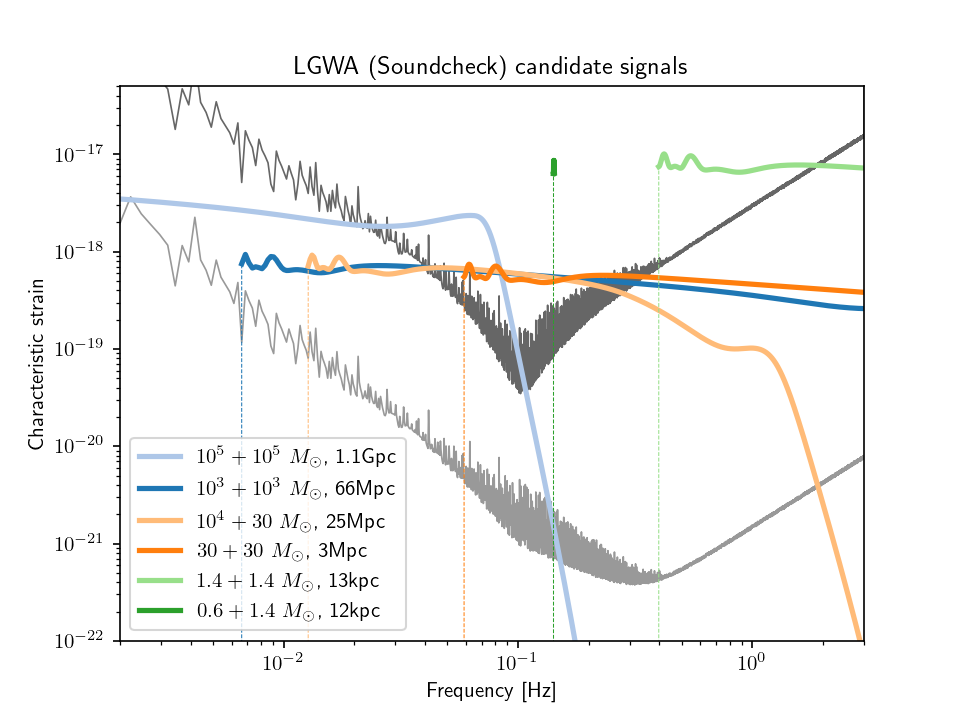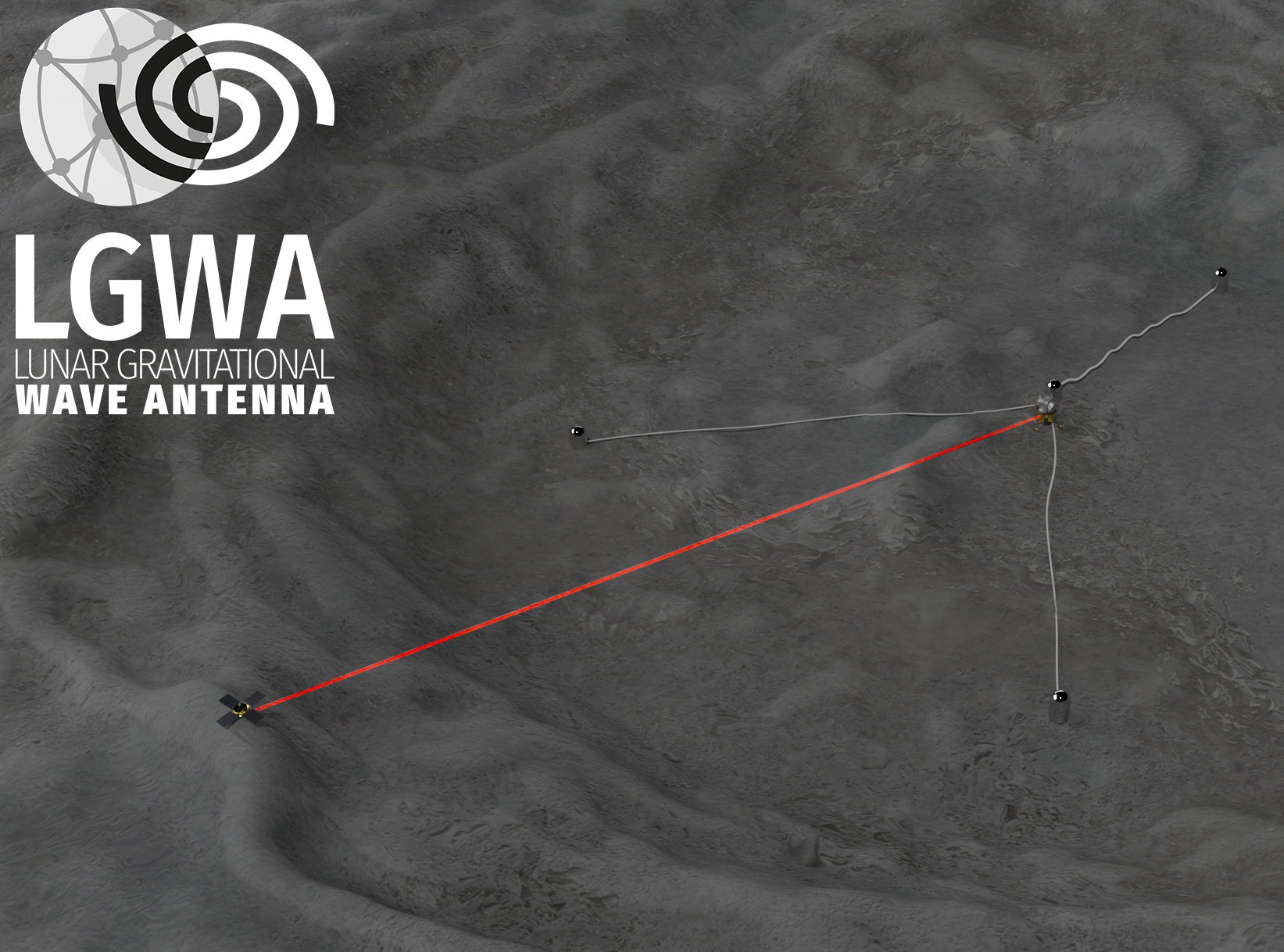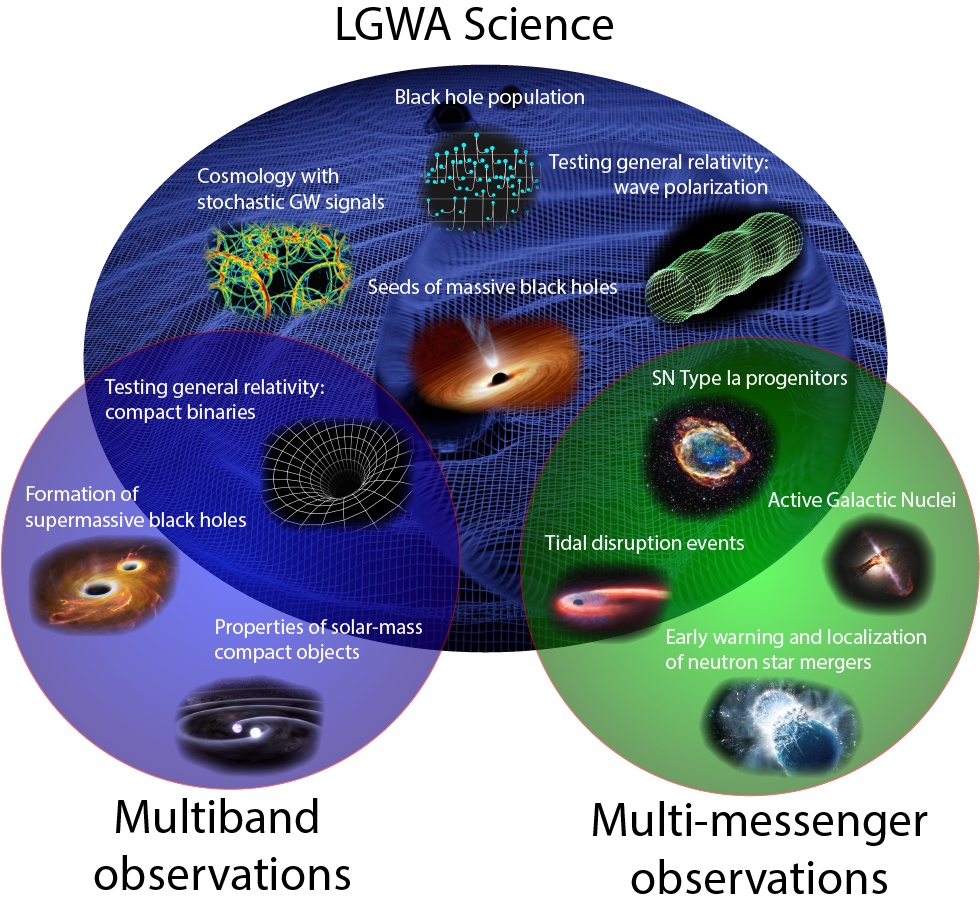The Lunar Gravitational-wave Antenna (LGWA) is a mission concept to measure the vibrations of the Moon caused by Gravitational Waves (GWs). Its observation band reaches from 1mHz to a Hz, with peak sensitivity in the decihertz band. Its pathfinder mission Soundcheck was selected in 2023 by ESA into the Reserve Pool of Science Activities for the Moon.

Characteristic strain sensitivities for signals detectable with Soundcheck (dark gray) assuming 2 months of observation time. Its detection horizon will be vastly exceeded by LGWA (light gray) with detections of intermediate-mass black-hole binaries becoming possible beyond z=10. Signal traces were simulated with GWFish.
LGWA will provide the ``missing link'' complementing the Laser Interferometer Space Antenna (LISA), which will observe below the decihertz band, and proposed future terrestrial detectors like the proposed Cosmic Explorer (CE) and Einstein Telescope (ET), whose observation bands lie above a few Hertz.

Star-like deployment configuration of four LGWA stations in a kilometer-scale array equipped with cryogenic inertial sensors. The LGWA deployment site is one of the permanently shadowed regions (PSRs) inside a crater at the lunar north or south pole. A laser-power beaming system is shown as a possible power system for LGWA.
Two components of LGWA are crucial for its success as a ground-breaking decihertz GW observatory:
- a cryogenic inertial sensor concept for the measurement of horizontal ground displacements reaching femtometer sensitivity at 1Hz;
- deployment of a kilometer-scale array of at least four inertial sensors and using advanced noise-cancellation techniques for the reduction of seismic background noise in the decihertz band. At least four stations are required to create a configuration of one sensor being surrounded by other sensors in all directions for efficient noise cancellation. In fact, any lunar detector targeting the decihertz band requires an array of LGWA-grade inertial sensors to reduce the seismic background noise, since the background is random in nature and can only be analyzed with locally acquired array data.
Deployment and operation: LGWA sensors need to be deployed inside a PSR whose natural cryogenic environment leads to improved sensitivity of the inertial sensors and also eliminates thermal noise and seismic disturbances induced by solar radiation. The targeted lifetime of LGWA is 10 years, which benefits the science outcome especially with respect to the observation of rare events, and which is long enough to be able to extend the network beyond the baseline configuration proposed here. The long operation at cryogenic temperatures and without sunlight is an important technological challenge.
GW science: As decihertz GW detector, LGWA has access to a unique band of masses and energies of GW sources, which cannot be studied by other GW detectors at high signal-to-noise ratio and out to high redshift. The decihertz band is of prime interest to cosmological studies, fundamental physics, and astrophysics.

Graphical summary of the LGWA science case including multi-messenger studies with electromagnetic observatories and multiband observations with space-borne and terrestrial GW detectors.
As link between space-borne and terrestrial detectors, LGWA is an ideal partner for multiband studies where these detectors observe the same GW signals at different phases of their frequency evolution. Also, the wealth of astrophysical sources observable by LGWA containing binaries with white dwarfs and neutron stars, tidal disruption events, or massive and supermassive black holes with accretion disks leads to a rich multi-messenger science case.
Lunar science and exploration: As an array of seismic stations, LGWA would be able to provide unique contributions to a future lunar seismic network. The most important will be the recording of normal modes excited by moonquakes. Moreover, it is conceivable that GWs can be used as probes to better understand the lunar interior structure by observing how the Moon responds to GWs. Meteoroid impacts, most of them weak seismic events by Earth's standards, can be used as probes to analyze the shallow Moon structure. LGWA will contribute to and improve the catalogue of moonquakes by reducing the event detection threshold and extending to lower magnitude events. These new data together with the use of modern machine-learning methods will contribute to the next generation of Moon interior models.
Geophysical missions of interest: The Farside Seismic Suite (FSS) will be deployed in the Schrödinger basin on the Moon with an approved CLPS-PRISM mission (expected to launch in 2024/2025) adopting the sensor design of the Mars InSight mission. Since the FSS seismometer will have greatly improved sensitivity over the Apollo seismometers, we can expect new insight into the distribution of weak seismic disturbances to the benefit of LGWA. The Lunar Geophysical Network (LGN) was proposed consisting of 4 separate deployments on the Moon.
